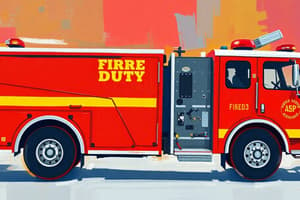Podcast
Questions and Answers
According to the Hurt on Duty Policy, what is the primary reason for having specific procedures for investigating and reporting incidents?
According to the Hurt on Duty Policy, what is the primary reason for having specific procedures for investigating and reporting incidents?
- To ensure all employees receive overtime pay for injuries.
- To punish employees who get hurt while performing normal job duties.
- To provide care and treatment for employees who have been injured or become ill on duty. (correct)
- To track the number of employee sick days.
According to the Hurt on Duty Policy, what must an employee do immediately if they are injured during the performance of normal job duties and it is medically feasible?
According to the Hurt on Duty Policy, what must an employee do immediately if they are injured during the performance of normal job duties and it is medically feasible?
- Contact their supervisor to report the incident and seek advice. (correct)
- File for worker's compensation.
- Contact their family.
- Go home and rest.
According to the Hurt on Duty Policy, what action should a supervisor take if an officer's injury prevents them from reporting it themselves?
According to the Hurt on Duty Policy, what action should a supervisor take if an officer's injury prevents them from reporting it themselves?
- Wait until the employee is able to report the incident.
- The supervisor investigating the incident will file the required reports for the employee. (correct)
- Take no action, as it is the employee's responsibility to report.
- File a preliminary report and wait for the employee to complete the report when they are able.
What is the first step an employee should take when involved in a vehicle accident while on duty, as outlined in the Risk Management Reporting Requirements?
What is the first step an employee should take when involved in a vehicle accident while on duty, as outlined in the Risk Management Reporting Requirements?
What is a supervisor's responsibility concerning reports related to vehicle accidents involving department employees?
What is a supervisor's responsibility concerning reports related to vehicle accidents involving department employees?
Following a workplace injury, what action must be taken immediately according to the Protocol for Workplace/On Duty Injuries?
Following a workplace injury, what action must be taken immediately according to the Protocol for Workplace/On Duty Injuries?
Who is responsible for completing the City of Fort Wayne Accident/Injury Investigation Report following a workplace injury?
Who is responsible for completing the City of Fort Wayne Accident/Injury Investigation Report following a workplace injury?
If an employee has a non-life-threatening injury or exposure, where should they go for care, according to the protocol?
If an employee has a non-life-threatening injury or exposure, where should they go for care, according to the protocol?
What is the most important initial action a supervisor must take concerning an employee's needs after an on-duty injury?
What is the most important initial action a supervisor must take concerning an employee's needs after an on-duty injury?
In the event of an employee injury, where should the supervisor ensure the injured employee is treated as soon as possible?
In the event of an employee injury, where should the supervisor ensure the injured employee is treated as soon as possible?
What information should a supervisor include in their incident report following an employee injury?
What information should a supervisor include in their incident report following an employee injury?
What action must the supervisor take after completing the incident report for an employee injury?
What action must the supervisor take after completing the incident report for an employee injury?
What action should the Commander of the Day (COD) take when an Injured on Duty incident occurs?
What action should the Commander of the Day (COD) take when an Injured on Duty incident occurs?
What is the Fort Wayne Police Department's Exposure Control Plan (ECP) designed to provide?
What is the Fort Wayne Police Department's Exposure Control Plan (ECP) designed to provide?
What is the timeframe within which a Fort Wayne Police Department employee should be notified of the findings of an investigation if they are exposed to a potentially life-threatening infectious disease?
What is the timeframe within which a Fort Wayne Police Department employee should be notified of the findings of an investigation if they are exposed to a potentially life-threatening infectious disease?
According to the policy, what is the first action a department employee should take if they suspect exposure to a life-threatening infectious disease?
According to the policy, what is the first action a department employee should take if they suspect exposure to a life-threatening infectious disease?
If an employee and their supervisor complete an "Infectious Disease Exposure" form, what is the purpose of this form?
If an employee and their supervisor complete an "Infectious Disease Exposure" form, what is the purpose of this form?
Following a documented exposure to an infectious disease, what support must the department make available to the exposed employee?
Following a documented exposure to an infectious disease, what support must the department make available to the exposed employee?
According to the policy, under what condition can an officer who tests positive for an infectious disease continue to work?
According to the policy, under what condition can an officer who tests positive for an infectious disease continue to work?
What information do the Fort Wayne Police Department and Risk Management maintain in the accurate record for each employee experiencing an occupational exposure?
What information do the Fort Wayne Police Department and Risk Management maintain in the accurate record for each employee experiencing an occupational exposure?
How long are health care records retained by the Fort Wayne Police Department and Risk Management for employees experiencing an occupational exposure?
How long are health care records retained by the Fort Wayne Police Department and Risk Management for employees experiencing an occupational exposure?
According to Appendix A, what action is initially required when obtaining a blood sample from a source patient who is not in custody?
According to Appendix A, what action is initially required when obtaining a blood sample from a source patient who is not in custody?
If a non-custodial individual consents to provide a blood sample, which actions should be taken next?
If a non-custodial individual consents to provide a blood sample, which actions should be taken next?
If an individual is in custody and consent for a blood draw cannot be obtained, what procedure should be initiated?
If an individual is in custody and consent for a blood draw cannot be obtained, what procedure should be initiated?
If a warrant is required to obtain a blood sample from an individual who is not in custody, what actions are permissible?
If a warrant is required to obtain a blood sample from an individual who is not in custody, what actions are permissible?
What is the next step after contacting the “On-Call Judge” to coordinate the Judge's signature for an exposure warrant?
What is the next step after contacting the “On-Call Judge” to coordinate the Judge's signature for an exposure warrant?
What documents should be included when completing the search warrant?
What documents should be included when completing the search warrant?
Who coordinates with the on-call nurse to determine the logistics (when, where, and by whom the blood draw will be done) when serving a warrant?
Who coordinates with the on-call nurse to determine the logistics (when, where, and by whom the blood draw will be done) when serving a warrant?
After the warrant is served, where should the copies of the warrant be forwarded?
After the warrant is served, where should the copies of the warrant be forwarded?
According to the policy, if there are any questions or concerns during the blood draw process, who should be contacted?
According to the policy, if there are any questions or concerns during the blood draw process, who should be contacted?
According to the policy, who should be contacted if the incident occurs outside of business hours and you are unable to reach anyone at the City Law office?
According to the policy, who should be contacted if the incident occurs outside of business hours and you are unable to reach anyone at the City Law office?
According to the Hurt on Duty Policy, what reports are required when a department employee is injured and it is medically feasible for them to report it?
According to the Hurt on Duty Policy, what reports are required when a department employee is injured and it is medically feasible for them to report it?
According to the procedures outlined for exposures and non-life threatening injuries, what step must be followed after visiting the Business Health Clinic?
According to the procedures outlined for exposures and non-life threatening injuries, what step must be followed after visiting the Business Health Clinic?
According to the policy, which of the following is a supervisor NOT responsible for when investigating an employee injury?
According to the policy, which of the following is a supervisor NOT responsible for when investigating an employee injury?
Concerning an employee's work status when they test positive for an infectious disease, how are those decisions made?
Concerning an employee's work status when they test positive for an infectious disease, how are those decisions made?
Flashcards
Purpose of hurt on duty policy?
Purpose of hurt on duty policy?
To provide specific procedures for investigating and reporting incidents in which department employees have been hurt on duty.
Critical importance to the department?
Critical importance to the department?
The health, well-being, and availability for duty of all personnel.
Employee's responsibility if injured?
Employee's responsibility if injured?
Employee must immediately report the incident to their supervisor and fill out required reports.
Required reports after an incident?
Required reports after an incident?
Signup and view all the flashcards
Risk management reporting (vehicle accidents)?
Risk management reporting (vehicle accidents)?
Signup and view all the flashcards
Protocol for workplace injuries?
Protocol for workplace injuries?
Signup and view all the flashcards
Supervisor responsibilities?
Supervisor responsibilities?
Signup and view all the flashcards
Purpose of Exposure Control Plan (ECP)?
Purpose of Exposure Control Plan (ECP)?
Signup and view all the flashcards
Employee suspects exposure to infectious disease?
Employee suspects exposure to infectious disease?
Signup and view all the flashcards
Paperwork after exposure?
Paperwork after exposure?
Signup and view all the flashcards
Maintains accurate records for employees with occupational exposure?
Maintains accurate records for employees with occupational exposure?
Signup and view all the flashcards
First step in blood borne pathogen exposure?
First step in blood borne pathogen exposure?
Signup and view all the flashcards
First step to complete a search warrant?
First step to complete a search warrant?
Signup and view all the flashcards
Serving the Warrant?
Serving the Warrant?
Signup and view all the flashcards
Study Notes
- This policy outlines procedures for investigating and reporting incidents where department employees are injured or become ill on duty.
- The well-being and availability of all personnel are critical to the department.
- Employees must immediately inform the department of circumstances that hurt their health while on duty.
- IC 36-8-4-5 provides for the care of police officers and firefighters injured or contracting illnesses in the line of duty.
Employee Responsibilities for On-Duty Injuries
- If medically feasible, an injured employee must immediately contact their supervisor, report the incident, seek advice, and fill out required reports.
- Required reports include: (1) "Spillman Report," (2) "City of Fort Wayne Accident/Injury Investigation Report," and (3) Infectious Disease Exposure Report (if necessary).
- If it's not medically feasible for the officer to report the injury, the supervisor investigating the incident will complete the required reports.
Risk Management Reporting for Vehicle Accidents
- Contact the dispatcher immediately after being involved in an accident.
- Complete the City of Fort Wayne Accident/Injury Investigation Report.
- Take the vehicle to the City Garage at 1705 S. Lafayette St. within 24 hours of the accident.
- Provide the City Garage with the Control Number and identify vehicle damage.
- Supervisors must collect all reports and forward copies to the Fort Wayne Police Department Fleet Manager.
Protocol for Workplace/On-Duty Injuries
- Report all workplace injuries or exposures immediately to a supervisor or command officer.
- Have a supervisor complete the City of Fort Wayne Accident/Injury Investigation Report and forward it to the Chief's Office.
- For exposures and non-life-threatening injuries, go to Business Health Clinic.
- All follow-up visits must be conducted through the system that provided the initial care.
Supervisor's Responsibilities
- Ensure the employee's needs are met and investigate all facts concerning the incident if possible.
- Ensure the injured employee is treated as soon as possible at the nearest hospital, emergency room, or Business Health Clinic.
- Investigate the incident and:
- Assign a case control number.
- Determine all facts and circumstances involved.
- Inspect the location where the incident occurred.
- Interview the injured employee and all witnesses, recording names and addresses.
- Take digital images of any visible injuries, if possible.
- Assemble all medical reports and opinions in the investigative report, obtaining medical release forms
- Note in the report if the injury or illness is a recurrence of a previously reported incident, referencing the prior complaint control number.
Supervisor's Incident Report Requirements
-
Include the Report Complaint Control Number.
-
Include the Employee Name/Rank/Title.
-
Include the Date/Time/Location of Incident.
-
Include a Brief description of the injury sustained.
-
The Supervisor will notify Communications to contact the on-call Risk Management employee.
Commander of the Day (COD) Responsibilities
- The COD will make entries in the log, noting the Injured on Duty incident with a brief description, date, time, and complaint control number.
- If the injury or illness requires hospitalization, the COD will make all appropriate notifications.
General Illness Exposure Guidelines
- The Fort Wayne Police Department's Exposure Control Plan (ECP) provides the strategy for limiting exposure to BBPs and other infectious agents responding to potential exposure incidents.
- The plan is available for review by all members through their immediate supervisor.
- All provisions of FWPD SOP PD98-0109, “Prevention of Bloodborne Diseases,” apply.
Exposure Control Plan (ECP)
- The ECP outlines procedures for when a Fort Wayne Police Department employee is exposed to a potentially life-threatening infectious disease.
- An initial investigation will be conducted, and the employee notified of the findings within 48 hours, with advice on any subsequent treatment.
Procedures for Exposure to Illnesses or Diseases
- If an employee suspects exposure to a life-threatening infectious disease, they must wash the area with soap and water and contact a supervisor.
- An initial medical evaluation should take place within one to two hours, if possible.
- The employee and supervisor will complete an “Infectious Disease Exposure” form.
- If the supervisor determines an actual exposure occurred, the "Exposure” form should be completed.
- Risk Management and Business Health will need the name and location of the source patient.
- If a blood sample is needed from the source patient, refer to Appendix A of this policy
Investigation
- BHS Case Manager will contact the employee to discuss the details of the exposure incident when known.
- BHS will contact the medical facility where the involved patient was transported/treated.
- BHS will notify the employee of the outcome and advise them of any subsequent treatment.
- Following a documented exposure, the department will provide confidential medical treatment and/or counseling.
Employees Testing Positive for Infectious Diseases
- Officers testing positive may continue to work if they maintain acceptable performance and do not pose a safety or health threat.
- The Fort Wayne Police Department will make all decisions concerning work status solely on medical opinions and advice.
- The department may require an employee to be examined by the department's health provider.
- All members of the Fort Wayne Police Department are to treat employees with a communicable disease fairly and courteously.
Record Keeping
- The Fort Wayne Police Department and Risk Management will maintain accurate records of occupational exposures, including vaccination status, tests, and healthcare provider opinions.
- These health care records will be kept secure with limited access for the member's employment plus 30 years. These records cannot be disclosed without the member's written consent.
Appendix A: Blood Borne Pathogen Exposure Warrant Protocol
- If obtaining a blood sample from the source patient is necessary, an attempt to acquire consent from the source patient to obtain a blood specimen must be made.
- If the individual is not in custody and consent is given:
- Transport is offered to an approved medical facility.
- Risk Management on-call personnel are notified of the situation.
- The blood draw will be done at the City's expense.
- If the individual is in custody:
- Consent for a blood draw can be obtained at the hospital or jail.
- Risk Management on-call personnel are notified of the situation.
- If consent cannot be obtained, it is required to initiate the process of obtaining a warrant.
- If the source of the exposure is not in custody, do not detain them and post an officer on their property until the warrant has been completed.
- Obtaining a warrant should take no more than an hour.
- Complete the Search Warrant.
Warrant Execution
- Contact the “On-Call Judge” through Communications to coordinate the Judge's signature.
- The “Exposure Warrant” template can be found on the FWPD intranet under "Forms"
- Fill in Dialogue boxes (control number, affiant, suspect/info, officer involved etc...)
- Type PC where is says “Replace with Narrative”
- Sign as the “Affined”
- Obtain the Judge's signature.
- Coordinate with the Judge regarding method (fax, email, etc...)
- Make at least 3 copies.
- Search Warrant Affidavit.
- Search Warrant.
- Return (date and time, what was collected)
- The supervisor/officer present will complete the Return
- Coordinate with the on-call nurse to determine when, where, and by whom the blood draw will be done
- On call nurse will decide how the sample is handled
- Fill in the “Return” on each copy and distribute as listed:
- Leave a copy of the warrant with the source patient/suspect
- Forward two copies to Internal Affairs
- For questions or concerns during the process, contact a City Attorney.
- During business hours from 8 am to 4 pm, Monday through Friday contact:
- Carol Helton-427-1395
- Malak Heiny- 427-2339
- Outside of business hours contact:
- Carol Helton – 260-409-2543
- Malak Heiny – 260-515-9492
Studying That Suits You
Use AI to generate personalized quizzes and flashcards to suit your learning preferences.





